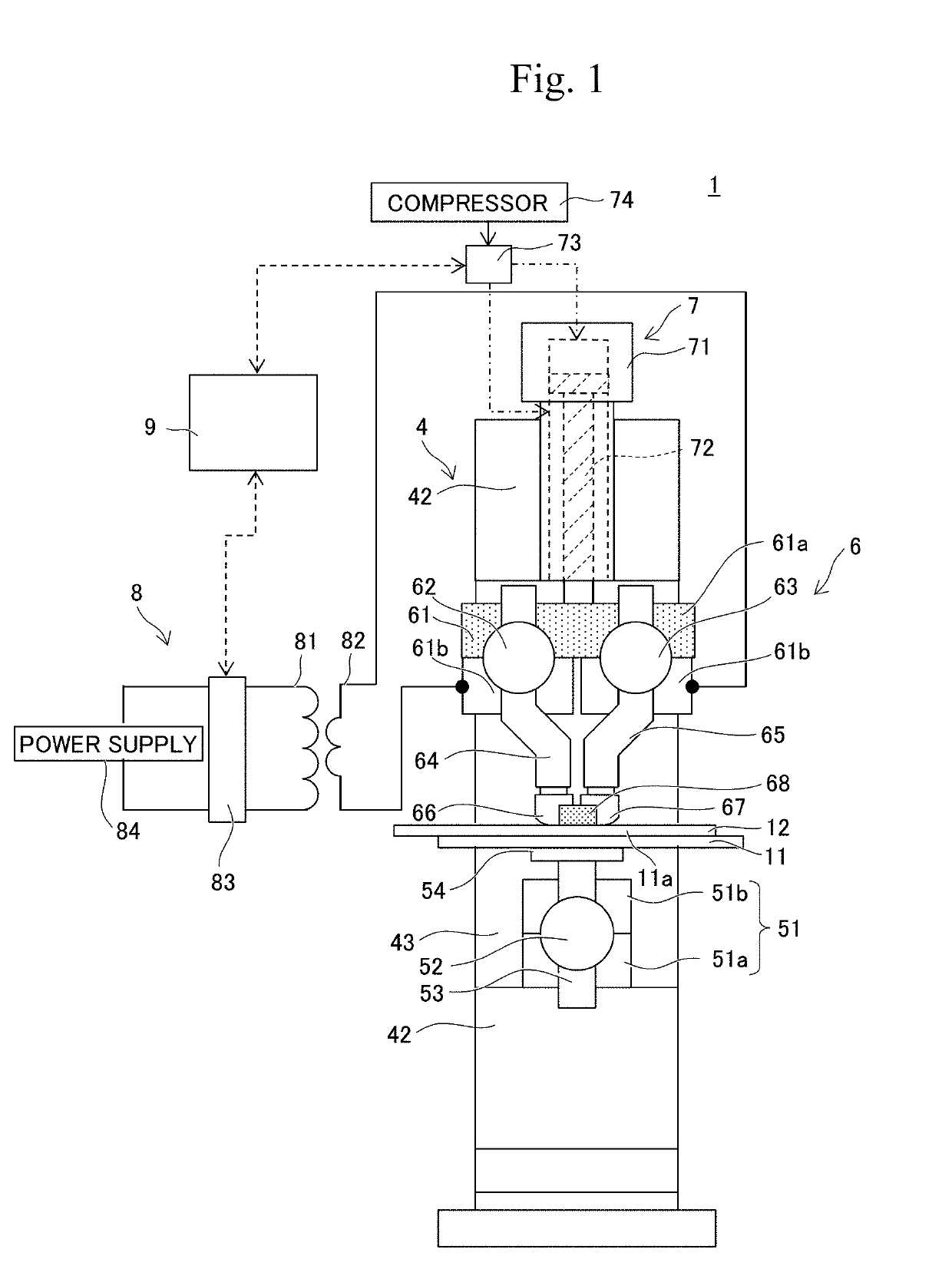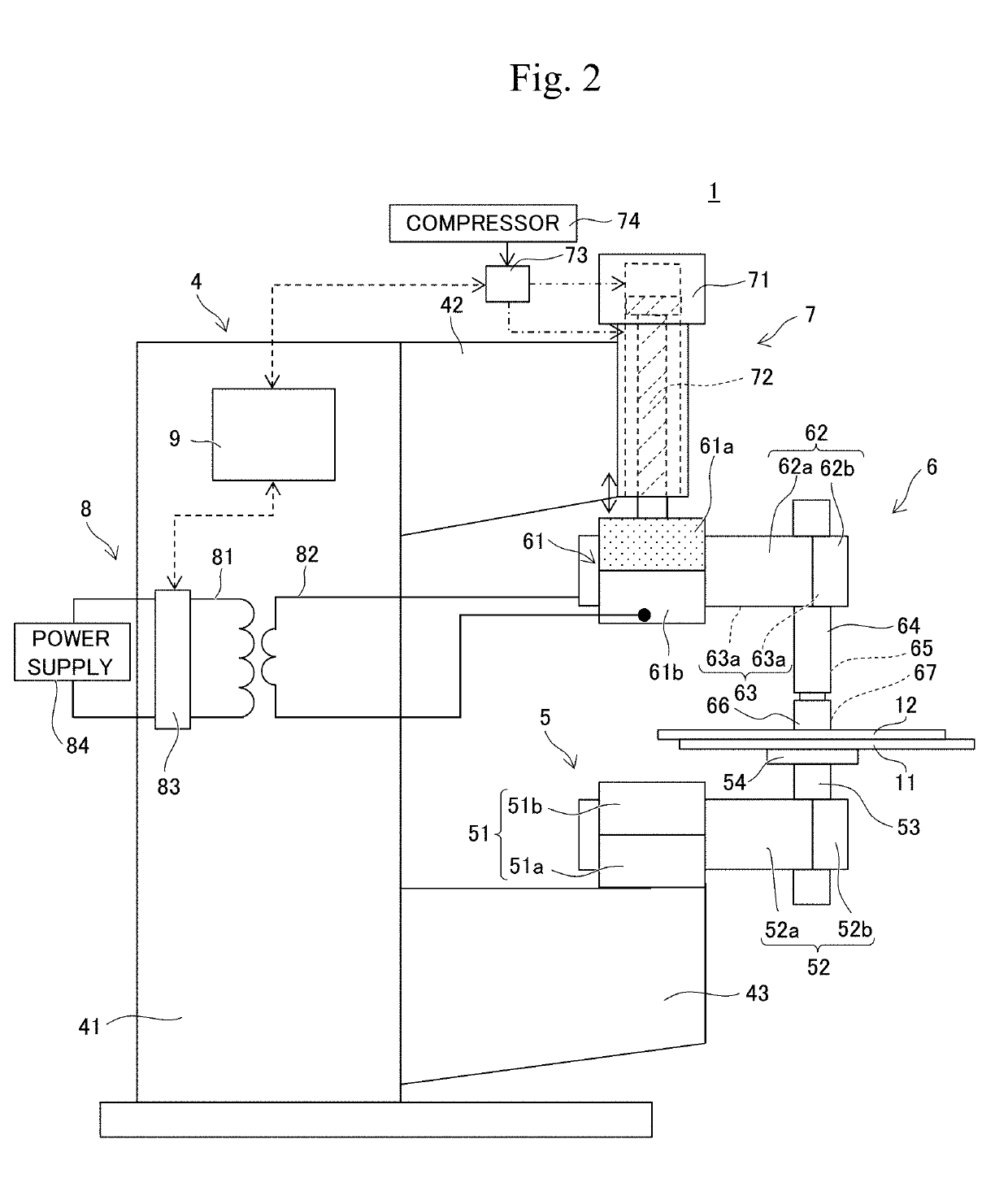Method for joining dissimilar metal plates
a metal plate and dissimilar technology, applied in the field of joining can solve the problems of insufficient joint strength of dissimilar metal plates, insufficient current supply of other metal plates, and difficulty in generating heat with current, so as to achieve the effect of enhancing joint strength and enhancing joint strength of two dissimilar metal plates made of different metallic materials
- Summary
- Abstract
- Description
- Claims
- Application Information
AI Technical Summary
Benefits of technology
Problems solved by technology
Method used
Image
Examples
example 1-1
[0065]The first metal plate and the second metal plate were joined using the resistance-welding apparatus shown in FIG. 1. First, 6000 series aluminum alloy with a plate thickness of 1.0 mm was prepared as the first metal plate, and a high-tension galvanized steel plate with a plate thickness of 0.7 mm was prepared as the second metal plate. Next, the first metal plate and the second metal plate were overlaid one on top of the other, and a pair of electrodes were brought into contact with the second metal plate with a pressure applied by the pair of electrodes and the pressurizing member set to 3.5 kN, a current supply time set to 0.42 msec, and welding current set to 8.4 kA as shown in Table 1, so that a test piece having the first metal plate and the second metal plate that are joined was produced.
examples 1-2 to 1-8
[0066]As in Example 1-1, test pieces of Examples 1-2 to 1-8 were produced. These examples are different from Example 1-1 in the conditions of the value of current supplied during welding as shown in Table 1 and FIG. 4. In Example 1-8, the second metal plate generated excessive heat during welding, and thus, the first metal plate was heated excessively, and the thus melted first metal scattered from the portion between the first metal plate and the second metal plate. In Examples 1-1 to 1-7, the first metal melted during welding did not scatter. Table 1 show these results. In Table 1, the presence or absence of the melting of the second metal plate during welding indicates the result obtained by confirming whether or not the second metal plate was welded to the electrodes and by observing the structure as described below.
examples 2-1 to 2-6
[0068]As in Example 1-1, test pieces of Examples 2-1 to 2-6 were produced. These examples are different from Example 1-1 in the conditions of the value of current supplied and the current supply time during welding as shown in Table 1 and FIG. 4. The current supply time of each of Examples 2-1 to 2-6 was 0.50 msec. In Example 2-6, the first metal of the first metal plate was heated excessively during welding, and the thus melted first metal scattered from the portion between the first metal plate and the second metal plate as in Example 1-8. Meanwhile, in Examples 2-1 to 2-5, the first metal melted during welding did not scatter. Table 1 shows the results.
PUM
| Property | Measurement | Unit |
|---|---|---|
| melting point | aaaaa | aaaaa |
| melting point | aaaaa | aaaaa |
| thickness | aaaaa | aaaaa |
Abstract
Description
Claims
Application Information
 Login to View More
Login to View More - R&D
- Intellectual Property
- Life Sciences
- Materials
- Tech Scout
- Unparalleled Data Quality
- Higher Quality Content
- 60% Fewer Hallucinations
Browse by: Latest US Patents, China's latest patents, Technical Efficacy Thesaurus, Application Domain, Technology Topic, Popular Technical Reports.
© 2025 PatSnap. All rights reserved.Legal|Privacy policy|Modern Slavery Act Transparency Statement|Sitemap|About US| Contact US: help@patsnap.com



